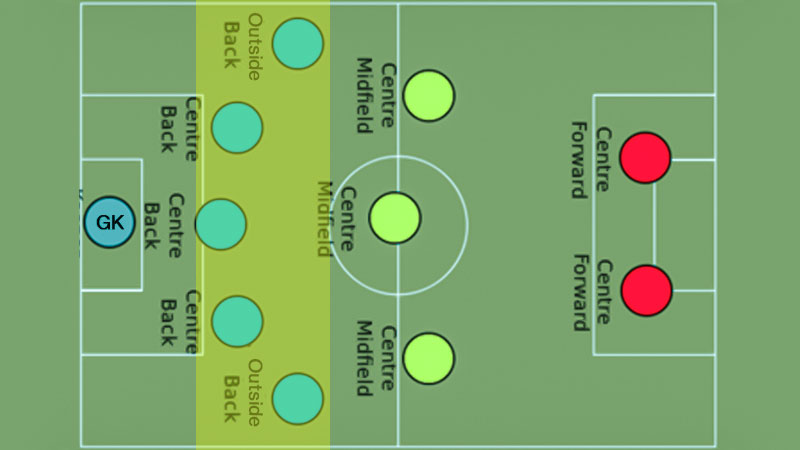In the dynamic world of soccer, the outside back position plays a crucial role in both defensive solidity and offensive creativity. These versatile players are tasked with providing defensive cover while also contributing to attacking plays, making them essential assets on the field.
With their speed, stamina, and tactical awareness, outside backs are often the unsung heroes of a team’s success.
Mastering the art of playing as an outside back requires a unique blend of skills, including solid defensive capabilities, precise passing, and the ability to overlap and support the attack.
Understanding the strategic positioning and timing of when to join the attack or fall back to defend is key to excelling in this position. As the game continues to evolve, the outside back position remains a pivotal role that demands adaptability and skill in equal measure.
Soccer Outside Back Position: Key Responsibilities
Soccer outside backs play a crucial role in both defensive and offensive aspects of the game. They need to seamlessly transition between supporting the defense and contributing to attacking plays.
Success in this position requires a diverse skill set that combines defensive prowess with offensive capabilities.
Defensive Duties: Protecting the Flanks
Outside backs are primarily responsible for protecting the flanks of the field. They must defend against opposition wingers and prevent them from delivering crosses into the box.
Maintaining a strong defensive stance, anticipating opponents’ moves, and making timely tackles are essential for outside backs to thwart attacks down the flanks.
Offensive Contributions: Supporting the Attack
In addition to their defensive duties, outside backs play a key role in supporting the team’s attack. They often overlap with wingers to provide width to the offense, create passing options, and deliver crosses into the box.
Their ability to join the attack while ensuring defensive coverage is crucial for maintaining offensive pressure and creating scoring opportunities.
Balance and Coordination with Midfielders and Forwards
Outside backs must strike a balance between their defensive and offensive responsibilities while coordinating effectively with midfielders and forwards.
They need to communicate with teammates, read the flow of the game, and make quick decisions to support both the defense and the attack.
Maintaining synergy with midfielders and forwards is essential for cohesive team play and successful game execution.
Essential Skills for Effective Outside Backs
To excel as an outside back in soccer, several key skills are essential. These skills encompass both defensive solidity and offensive contributions, making outside backs versatile and indispensable on the field.
Here are the essential skills for effective outside backs:
Technical Skills: Passing and First Touch
Passing and first touch are critical technical skills for outside backs. It’s important for them to have precise passing abilities to distribute the ball effectively during build-up play or switch the point of attack.
Their first touch needs to be controlled and quick to maintain possession under pressure. For example, when an outside back receives the ball from a teammate, a good first touch allows them to quickly transition into an attacking position or make a safe pass to maintain possession.
Physical Skills: Speed and Endurance
Outside backs rely on their speed and endurance to cover long distances on the pitch. Speed is essential for both offensive and defensive situations. Whether chasing down an opposing winger or overlapping to join the attack, speed is a key physical attribute for outside backs.
Endurance is equally important as they are often required to make overlapping runs up and down the flank throughout the entire match. It’s crucial for outside backs to maintain their stamina to fulfill their dual defensive and offensive roles effectively.
Tactical Skills: Reading the Game and Positioning
Reading the game and positioning are tactical skills that separate good outside backs from great ones. They need to anticipate the movements of opposition players, intercept passes, and make timely tackles to regain possession.
Additionally, their positioning on the field is crucial for maintaining defensive shape and providing passing options when the team is in possession. A well-positioned outside back can both shut down opposition attacks and contribute effectively to their team’s offensive strategies.
Training and Development Tips for Outside Backs
Playing as an outside back in soccer requires a combination of defensive skills, offensive prowess, and tactical awareness. To excel in this position, players need to continuously work on improving various aspects of their game.
Here are some valuable training and development tips specifically tailored for outside backs.
Drills to Improve Defensive Techniques
Improving defensive techniques is crucial for outside backs to excel in their role. Here are some drills specifically designed to enhance defensive skills:
1v1 Defending Drill
Practice scenarios where the outside back has to defend against an opponent in a one-on-one situation. This helps develop skills like timing tackles, body positioning, and forcing the opponent wide.
Recovery Speed Exercises
Emphasize drills that enhance the ability to recover quickly after an attacking play breaks down. This is crucial for outside backs who need to support the defense when under pressure.
Crossing and Heading Drills
Work on defensive headers and crossing under pressure to improve aerial duels and clearances. These skills are vital for outside backs when defending set-pieces and crosses.
Exercises to Enhance Offensive Capabilities
Enhancing offensive capabilities is essential for outside backs to contribute effectively to their team’s attack. Here are some exercises tailored to improve their offensive skills:
Overlapping Runs Practice
Focus on making overlapping runs to support the midfield and attack. This drill helps outside backs improve their offensive contribution by creating width and overloading the opponent’s defense.
Shooting and Finishing Drills
Sharpen shooting and finishing skills to capitalize on attacking opportunities that may come the outside back’s way. They need to be proficient in making good decisions in the final third.
Combination Play Training
Practice combination plays with midfielders and wingers to enhance link-up play and create attacking overloads on the flanks. This improves the outside back’s ability to participate effectively in the team’s offensive strategies.
Understanding Defensive Shape
Focus on positioning and maintaining defensive shape to cover space effectively and support the center-backs when necessary. Tactical discipline is crucial for outside backs to prevent opposition attacks.
Attacking Transition Drills
Train to recognize moments to join the attack quickly and effectively. Outside backs play a vital role in transitioning from defense to attack, so understanding when and how to contribute offensively is essential.
Communication and Coordination
Work on communication with teammates to ensure cohesive defensive and offensive strategies. Outside backs need to coordinate with center-backs, midfielders, and wingers to maintain a balanced team shape and cover for each other when needed.
Famous Examples of Successful Outside Backs
Renowned for their versatility and impact, famous outside backs like Cafu, Lahm, Roberto Carlos, and others have redefined soccer with their defensive solidity and attacking prowess.
Cafu
Cafu is considered one of the greatest outside backs in soccer history. He played for clubs like AS Roma and AC Milan and won numerous domestic and international titles.
Known for his speed, crossing ability, and defensive prowess, Cafu revolutionized the role of the modern full-back.
Philipp Lahm
Lahm, a versatile player, excelled as an outside back for both Bayern Munich and the German national team. He was known for his intelligence on the field, tactical awareness, and exceptional positioning.
Lahm’s leadership and consistency made him a role model for aspiring defenders worldwide.
Roberto Carlos
Roberto Carlos, famous for his powerful strikes and attacking mindset, redefined the left-back position. Playing for Real Madrid, he showcased remarkable speed, skill, and an eye for goal. His free-kick goals are still remembered as some of the best in soccer history.
Trent Alexander-Arnold
Alexander-Arnold, a rising star at Liverpool, has made a significant impact as an attacking right-back. Known for his precise crosses, vision, and playmaking ability, he has redefined the role of modern outside backs.
His offensive contributions have been instrumental in Liverpool’s recent successes.
Andrew Robertson
Robertson, Alexander-Arnold’s counterpart at Liverpool, is known for his relentless work rate, defensive solidity, and overlapping runs. His combination of defensive discipline and attacking threat has made him one of the best left-backs in the world.
Robertson’s consistency and determination have earned him praise from fans and experts alike.
Achraf Hakimi
Hakimi, playing for Paris Saint-Germain, showcases blistering pace, technical skill, and an attacking mindset from the right-back position. His ability to contribute both defensively and offensively has made him a valuable asset for his teams.
Hakimi’s versatility and adaptability have established him as a top outside back in the current soccer landscape.
Frequently Asked Questions
What is the role of outside backs in soccer?
Outside backs in soccer play a crucial role in both defense and offense. They provide width to the team, support attacks, and help in defensive duties by marking opposition wingers.
What skills are essential for success as an outside back?
Successful outside backs require a blend of technical, physical, and tactical skills. This includes good passing, crossing, tackling, speed, stamina, defensive awareness, and the ability to join attacking plays effectively.
How can a player train to improve as an outside back?
Training tips for outside backs include practicing crossing and passing accuracy, improving defensive positioning, working on speed and agility, enhancing communication with teammates, and studying the game to understand when to join attacks or stay in defense.
Who are some renowned outside backs in soccer history?
Renowned outside backs in soccer history include players like Cafu, Philipp Lahm, Roberto Carlos, Trent Alexander-Arnold, Andrew Robertson, and Achraf Hakimi. These players are known for their exceptional skills and contributions to the outside back position.
Conclusion
The evolution of the outside back position is complex, involving a blend of speed, intelligence, attacking prowess, and defensive solidity seen in players like Cafu, Lahm, Carlos, Alexander-Arnold, Robertson, and Hakimi.
Exceptional outside backs excel due to their dedication in mastering technical, physical, and tactical aspects, enabling them to seamlessly transition between defensive and attacking roles.
Emphasizing defensive shape, attacking transitions, and effective communication not only enhances individual performance but also benefits the overall team dynamic, showcasing the ongoing evolution of soccer positions.
The legacy of influential outside backs sets new standards and inspires a new generation of players to redefine traditional roles in the sport.
These elite players demonstrate the critical attributes needed for success in the outside back position, inspiring a new wave of talent to push boundaries and redefine the role further.








Brice Petersen